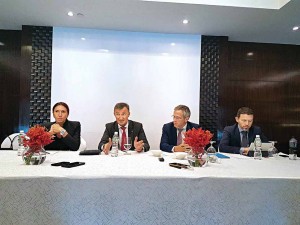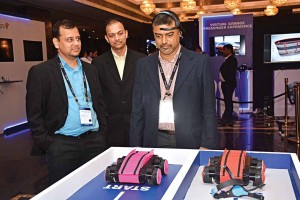Dassault Systèmes aims to redefine the development and manufacture of commercial vehicles through innovative and sustainable solutions.
Story by: Ashish Bhatia
With an eye on the Indian auto industry, Dassault Systèmes is looking to redefine the development of commercial vehicles through innovative solutions like ‘3DExperience’. ‘3DExperience’ is a business experience platform that enables users to weigh the pros and cons of a prototype without physically building one. Serving CV OEMs like Volvo Eicher Commercial Vehicles, Ashok Leyland, Mahindra & Mahindra, and others, the company, at the 3DExperience Forum India 2017, held at Mumbai, announced that it wants to extend virtual universes to the commercial vehicle industry in India. Stressing upon the tie-up with Volvo Eicher Commercial Vehicles to enable it to take a new approach to product development with the use of ‘3DExperience’, Dassault Systemes aptly made it clear that it is looking to help CV makers to transform the way they design, develop and produce vehicles. Dassault Systemes sources revealed that Volvo Eicher Commercial Vehicles is looking at integrated digital data management experience to boost quality and productivity, and at the ‘3DExperience’ to accelerate vehicle development for regional requirements. Claimed to blur the line between the virtual world and the real world, the ‘3DExperience’, according to Olivier Sappin, Vice President, Transportation & Mobility Industry, Dassault Systèmes, provides digital continuity to accelerate innovation, improve product quality, performance, and reduce the engineering lead time and costs. Of immense value to commercial vehicle manufacturers, Sappin said that 60 per cent of the automobiles sold today are designed or engineered by using Dassault Systèmes.
The right platform
Providing software solutions to help organisations to create value in their quest to offer a different experience with a single, easy-to-use interface, ‘3DExperience’ is helping businesses to design, analyse, simulate in a collaborative and interactive environment. It is helping businesses to test and evaluate a product or service at any stage in its development life cycle. ‘3DExperience’, according to Sappin, is giving rise to a final experience that is unique, impressive and value enhancing for the customers. Pointing at 3D printing, which helps to create a physical object from a three-dimensional digital drawing by laying down many thin layers of a material in succession, Sappin averred, “Manufacturers are producing 3D printing machines at the cost of a mobile phone, and of a good quality.” “Sophisticated industries are set to evolve, and we are looking at the cloud to offer our solutions,” he averred.
Transportation & Mobility
Constituting 50 per cent of Dassult Systemes’ business in India, the Transportation & Mobility sector is innovating and trying out new ways to sustain as well as grow. Constituting 30 per cent of Dassault Systemes’ business the world over, the ‘3DExperience’ makes a fit case for driving modularisation, and to manage competition. From strategic planning to design and manufacture, it provids a key to prepare a holistic definition of the product development process. Remarked Sappin, “We are looking at regulating the data that truck makers can get from a telematics solution. It will act as a feedback to engineering in a bid to constantly upgrade the product.” Expecting CV makers to use ‘3D Experience’ to gain a modular, glo-cal (global and local) and secure outlook, CV manufacturers are taking time to acknowledge the gains. Said R S Sachdeva, COO, Eicher Trucks & Buses, that it took 18 months to recognise business process efficiencies. These are expected to help the CV OEM to test new ideas, accelerate product verification and validation, and deliver innovative products to the market faster and at less cost. Informed Sachdeva, “With 3DExperience platform, we can digitally ensure that our customers’ interests are represented at every phase of product development, from product strategy to the shop floor.”
Based on the ‘3DExperience’ platform, the modular, glo-cal and secure industry solution experience unifies digital information in a single collaborative environment that is accessible and aids product planning and portfolio management, product development, vehicle integration, and manufacturing planning. It also provides partner access. Enabling the company to address the complexity of a diverse product portfolio with good agility; configure and manage global product designs, and to arrive at a bill of materials of all the variants, CV makers could look at meeting the evolving customer expectations for performance and quality. Empowering the CV maker to optimise costs and cycle times, ‘3DExperience’ aids to integrate processes, manage data, engineering and manufacturing value chain. “The value of virtual design is much higher than the cost of producing physically,” averred Sappin. He concluded, “We are going to see trading of design versus buying of parts given that there is a marginal cost of producing it. With the opportunity to electrify (automobiles) being massive, we are heavily investing in that space.”
Olivier Sappin, Vice President, Transportation & Mobility Industry, Dassault Systèmes
Q. How is Dassault Systemes supporting OEMs to modernise CVs?
A. Our common practice is to bring all technological domains together. We get the ‘Design Studio’ to not only look at style but also to look into the main architecture that includes parts like cabins, ergonomics and contours, etc. We have invested significantly to develop a composite solution. Our Virtual Reality (VR) solution for instance is being used by every truck maker to improve the end product. To give you an example, we have partnered with Fiat Chrysler Automobiles (FCA) for a Design Studio. FCA was looking beyond just design activities. We engineered an architecture to propose a modern cockpit and an external structure. This has today extended to trucks. Surprisingly, the scenario at times is reverse. There have been instances when the truck market has turned out to be more advanced than the passenger vehicle market. An example is telematics. Passenger vehicles are drawing from telematics in trucks.
Q. What is the extent of your involvement with Indian OEMs?
A. From an Indian context, both Ashok Leyland and Volvo Eicher Commercial Vehicles (VECV) are using our solutions. We are looking at simulating the behaviour of the driver, in terms of accessibility of steering, mirror vision, ABS, clutch, etc. We are helping CV makers to look at the next generation cabin design virtually. By using our VR solution, various stakeholders have come together and signed off officially on the form, fit and the finish of the vehicle in terms of acceptability from the marketing and sales perspective. This is a big change from traditional ways of development. Our visual tools aid to look out for issues and help to chalk out solutions that are validated without a prototype. Also, everything related to crash, NVH, optimisation of structures in lieu of weight reduction as a result of fuel efficiency norms coming into effect. Other areas include tyre, chassis, engine, transmission or an axle where weight reduction can be achieved without compromising durability and reliability.
Q. How do you look at the Indian market’s transition from a seller market to a buyer’s market?
A. The customer today has so many options. Applications are driving business in mining, and in market segments like milk vans among others. Customers are taking orders based on this. Complexity is created in terms of how many permutations and combinations could be had of the chassis, engine, etc. How the vehicle could fulfill the promise made to the customers. This is where digitisation comes in. This is where we at Dassault Systemes are helping customers to model and visualise virtually.
Q. Are you helping global OEMs to adopt frugal ways of working as they look at localisation?
A. An example I would like to mention is Renault. We are working with them in India to set up a vehicle platform for their global business. The Indian team wants to leverage what is globally available by using the potential of the platform to increase localisation. A big challenge is to make a vehicle on par with global standards at an Indian price. To successfully adopt global practices for collaboration, all the data is made available on a common collaborative platform from a single location. It applies to auto component manufacturers as well. Most component manufacturers conduct the entire design practice from one location. They are developing products as we speak. These could be export oriented, and will be manufactured at plants that are digitally connected in an effort to keep tab of the differing key metrics. The Cummins facilities in India, for instance, are digital, and connected.
Q. Could commercial vehicle manufacturing cycles shrink?
A. The VR solution that we are offering is being used by OEMs to ensure that the full visibility of the truck can be analysed well in time. This is expected to accelerate in the future. The Japanese have been doing this for a while now. One key initiative expected to contribute towards shrinking of cycles is component design. It is difficult to give a metric as such on the scale of reduction that could be achieved. It could be 18 months to 16 months in case of passenger vehicles for example. In case of a completely new platform, it could take more than 18 months. In case of a facelift, it could take just 12 months. It is completely dependent on the complexities involved.
Q. How much does it cost for a manufacturer to purchase the 3DExperience platform?
A. Our software is useful right at the development stage. For us, it is a new business. Capable of providing a platform for everything before commercialisation of the product, the projects that we are involved in are touching domains like big data and analytics among others. The core focus is to reduce the lead times up to the start of production. This has a definite impact on end costs. Capable of helping an OEM to optimise the price of a truck by connecting with the development of the vehicle at every manufacturing step, and helping to optimise it with respect to its platform, the solutions save costs. A truck would otherwise cost more. We work towards the end margin. The key metric here is the cost of quality. One has to be certain that the axle, transmission, cabin body and various components are engineered to last for three years or 10 lakh kilometres when promising the customers a three year warranty on a truck or a bus. It boosts confidence. The confidence drips down to the supplier level since it is he who is responsible for the quality of materials. The potential permutations and combinations of what could potentially go wrong are immense. We offer certainty. If the steel quality, design, thermal properties, loads and behaviour are digitally designed, the manufacturer is confident on the warranty he could offer. A potential problem discovered at the end of the production line could result in severe strain. It could lead to wastage; create a need to rework, and stall the line. The impact on total finish cost could be astronomical. It would impact inventory, finished goods inventory, scrap generation and disposal, prototype costs and the brand image. It is to avoid this that many manufacturers invest in our technology. Our approach is termed as cost quality, and is the primary driver for manufatcurers looking to apply these technologies. Our project with Fiat Chrysler Automobiles (FCA) in the form of Design Studio, for instance, would have an immediate impact on the top line. It is really about innovation and new features. If you look at Cummins, the impact would be on the bottom line as the objective is to make cost efficient truck engines.
Q. Are you offering solutions for tear down and benchmarking practices?
A. More and more companies are providing data. At OEMs, one would find many dismantled vehicles. The availability of digital data on competition has brought in a big change in the manufacturer’s approach. We are not involved in offering data as such. We don’t own any data from any competitor. More and more platforms are however using our data to compare the architecture, dimensions, etc. Our solutions are often used at the product planning and strategy stage itself. We also offer a product that helps companies to study their brand image. A manufacturer launching a new truck could get all the press articles, blogs, forums for typical brands and competition for comparison to gauge the reach. It was previously a standalone product used by marketing companies in retail spares. Today, auto companies are using it extensively.
Q.How does your approach to OEMs differ depending on whether it manufactures passenger vehicles or CVs?
A. We do not look at the life of the vehicle really. We look at everything from the product development standpoint. We have specific solutions for both segments. For commercial vehicle manufacturers, we have truck modularisation, driver management, and more. These solutions are dependent on the life expectancy.
Q. What are the key areas of growth that you are looking at in India?
A. We see a potential for growth in our core domain because of the regulatory changes. Regulatory changes are making OEMs invest in our solutions. A level of maturity is coming in. A clear new domain that is emerging is electrification and automation. We are extending our solutions to commercial vehicle manufacturing with OEMs looking to modernise and upgrade. There is a special focus on improving the overall supply chain planning in the backdrop of Goods and Services Tax (GST) and the way the ‘hub and spoke model’ is emerging. Our patented technology ‘Quntiq’ is a global leader in supply chain planning and optimisation. OEMs are willing to consider our solutions to reduce the burden on their working capital. It marks a crucial domain for us.






















